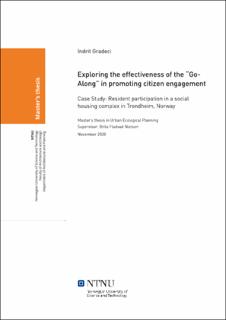| dc.description.abstract | Community participation is an integral part of decision-making processes as it presents clear understandings of the shared perceptions that every stakeholder has of their environment be it social or physical. To ensure maximum citizen engagement various qualitative methods have been implemented amongst which the go-along method has emerged as an immersive method of enquiry. This thesis investigates how the go-along method can engage citizens in planning processes by carrying out a systematic literature review and fieldwork focusing on the go-along method. The review showed that the go-along methods can be beneficial when applied to applied in health and wellbeing studies, student’s behavior in educational institutions, neighborhood studies, area redevelopment plans, etc.; however, few research gaps were identified: no application with a social housing context; recent advanced technology is not fully used; and, no semi-quantitative approach to evaluate the added value of the go-along method. Hence, this study applied the go-along method to investigate how it can engage social housing dwellers in planning processes of Boligstiftelsen. A multi-method approach was used in this study to provide a more comprehensive understanding of the context and to complement other method’s limitations. Four go-alongs, in-situ observations, a sit-down group interview, a focus group and a go-virtually-along were applied. Insta360 EVO, a 360° video camera, was used to film the go-alongs and focus group.
The study concludes that the go-along method can engage social housing dwellers in providing basis to translate their desires and insights into valuable input that can support urban planning processes. An essential benefit of applying the go-along method is to gather a wide variety and significant volume of data by engaging even a small sample of participants as shown from the results of the semi-quantitative approach used in this study. The go-along method’s potential is better exploited when used complemented to other traditional methods, such as in conjunction to focus group, in order to overcome its limitations in regard to the exclusion of participants with low or no mobility abilities. The case study demonstrated that technology, such as 360° video cameras, can overcome the method’s limitation of the need to simultaneously take notes and pictures while moving and focusing on the conversation with the participant. The case study demonstrated that the go-along method enhances the interaction researcher-citizens in the planning process by involving the researcher more in the community and making residents more interested in the ongoing research. | |
